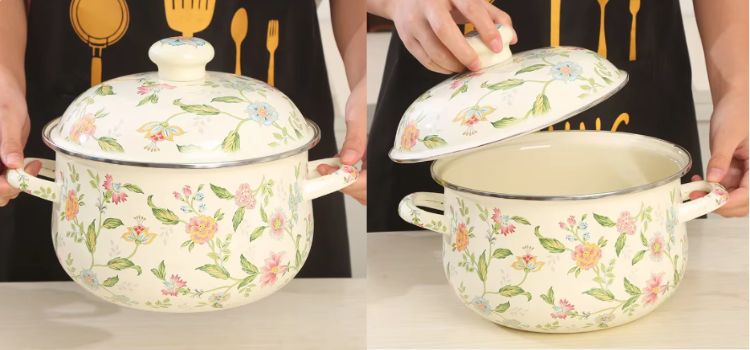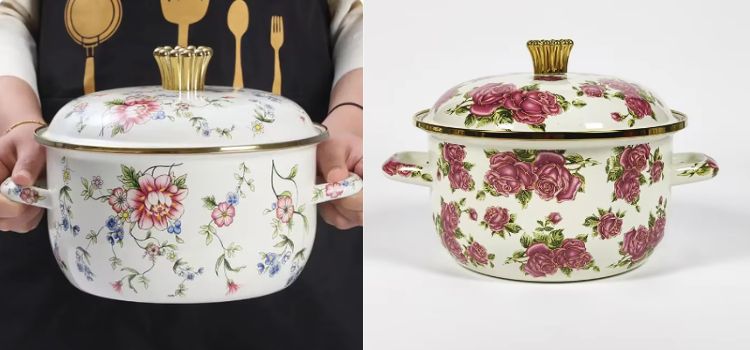As an Amazon Associate, I earn from qualifying purchases

In recent years, there has been a notable resurgence in the popularity of vintage enamel cookware. Much of this can be attributed to the nostalgic charm and aesthetic appeal that these colorful and often intricately designed pieces bring to a kitchen. But beyond their looks, many people are drawn to vintage enamel cookware for its reputation of durability and longevity.
However, with its renewed popularity comes a critical question: Is vintage enamel cookware safe to use in today’s kitchens? This article aims to explore this question by examining the composition, benefits, potential safety concerns, and expert opinions related to vintage enamel cookware.
Composition and Benefits of Enamel Cookware
- Composition: Enamel cookware consists of a metal core, usually cast iron, coated with a layer of enamel, a type of glass. This combination offers several advantages.
- Non-reactive Surface: The enamel coating provides a non-reactive surface, ensuring it doesn’t interact with acidic foods. This non-reactivity helps keep the flavors of your dishes pure and untainted.
- Ease of Cleaning: The smooth, glass-like surface of enamel cookware prevents food from sticking, making it easier to clean compared to many other cookware types.
- Visual Appeal: Enamel cookware comes in vibrant colors and glossy finishes, adding style to any kitchen. Many home cooks display their enamel pieces proudly.
- Vintage vs. Modern: Vintage enamel cookware often has a unique charm due to its historical context and craftsmanship. However, modern enamel alternatives may offer improved safety standards and advancements in manufacturing processes.
Potential Safety Concerns
Despite the many benefits, there are legitimate concerns associated with using vintage enamel cookware, primarily related to the presence of lead and cadmium in older enamel coatings. These heavy metals were sometimes used in the past to enhance color and durability, and they pose significant health risks if they leach into food.
A key factor influencing the safety of vintage enamel cookware is its condition. Chips, cracks, or signs of wear can expose the underlying metal and increase the risk of heavy metals leaching into food. Moreover, cooking acidic foods or using high heat can exacerbate this leaching process, especially if the enamel coating is compromised.
For those who own or are considering purchasing vintage enamel cookware, understanding these risks and how to mitigate them is crucial. The age and origin of the cookware can also be indicators of potential risks, as newer pieces are less likely to contain harmful substances due to stricter regulations in recent decades.
Scientific Studies and Expert Opinions

Research on the safety of vintage enamel cookware has produced mixed results. Some studies have identified elevated levels of lead and cadmium in certain vintage pieces, particularly those with bright colors or intricate designs, which were more likely to contain these metals. However, it’s important to note that not all vintage enamel cookware is hazardous, and many pieces may not pose significant risks.
Experts in health and culinary fields often advise caution when using vintage enamel cookware. While some suggest avoiding its use altogether, others propose a more nuanced approach, recommending that owners test their cookware for lead or cadmium presence, especially if they are unsure of its origin or age.
Health organizations continue to emphasize the importance of using cookware that complies with current safety standards. As a result, consumers are encouraged to seek information and, if necessary, replace vintage pieces with safer modern options while maintaining the aesthetic appeal they desire.
Tips for Safe Usage of Vintage Enamel Cookware
For those who wish to use vintage enamel cookware while minimizing health risks, there are several precautions that can be taken:
- Inspect Thoroughly: Before using a vintage piece, inspect it for any chips, cracks, or significant wear. These imperfections can compromise the safety of the cookware and should be addressed.
- Test for Lead and Cadmium: Consider conducting a home test for lead and cadmium, which can often be done using inexpensive test kits available online or in stores. This step is crucial if the cookware’s safety is in question.
- Limit Use of High Heat: When cooking with vintage enamel cookware, avoid using excessively high temperatures, which can increase the risk of leaching if the enamel is damaged.
- Avoid Cooking Acidic Foods: If you’re concerned about potential leaching, it might be best to avoid cooking highly acidic foods, like tomatoes or citrus-based dishes, in vintage enamel cookware.
- Routine Maintenance: Taking care of your vintage enamel cookware by avoiding harsh cleaning materials and using utensils that will not scratch the surface can extend its life and maintain its safety.
Conclusion
In conclusion, the safety of vintage enamel cookware is a nuanced topic. While there are legitimate concerns regarding the presence of heavy metals in older enamel coatings, not all vintage pieces pose the same level of risk. By understanding the potential dangers and following recommended safety practices, it is possible to use vintage enamel cookware safely.
Ultimately, the decision to use vintage enamel cookware should be based on a balance of aesthetic appreciation and safety considerations. For those who cherish these nostalgic pieces, the key lies in informed decision-making, ensuring that they can enjoy their vintage charm while keeping health risks at bay. As with many aspects of cooking and kitchenware, staying informed and making choices that align with personal comfort and safety is paramount.
FAQ
Is it safe to use vintage cookware?
Using vintage cookware can be safe if it is well-maintained and free of chips or cracks. However, some vintage pieces may contain lead or other harmful materials. Testing for these substances is advisable. Always inspect for damage and use caution when cooking acidic foods to minimize risks.
Is it safe to cook with enamel cookware?
Enamel cookware is generally safe, providing a non-reactive cooking surface that prevents food contamination. Ensure the enamel is intact and free from chips. Modern enamel cookware typically meets safety standards, but vintage pieces should be tested for lead or cadmium to ensure safe usage.
Is 1970s enamelware safe?
1970s enamelware can be safe if well-preserved and undamaged. However, some pieces from this era may contain lead in their coatings. It’s advisable to test for lead or cadmium presence and avoid using high heat or cooking acidic foods if the enamel is compromised.
As an Amazon Associate, I earn from qualifying purchases